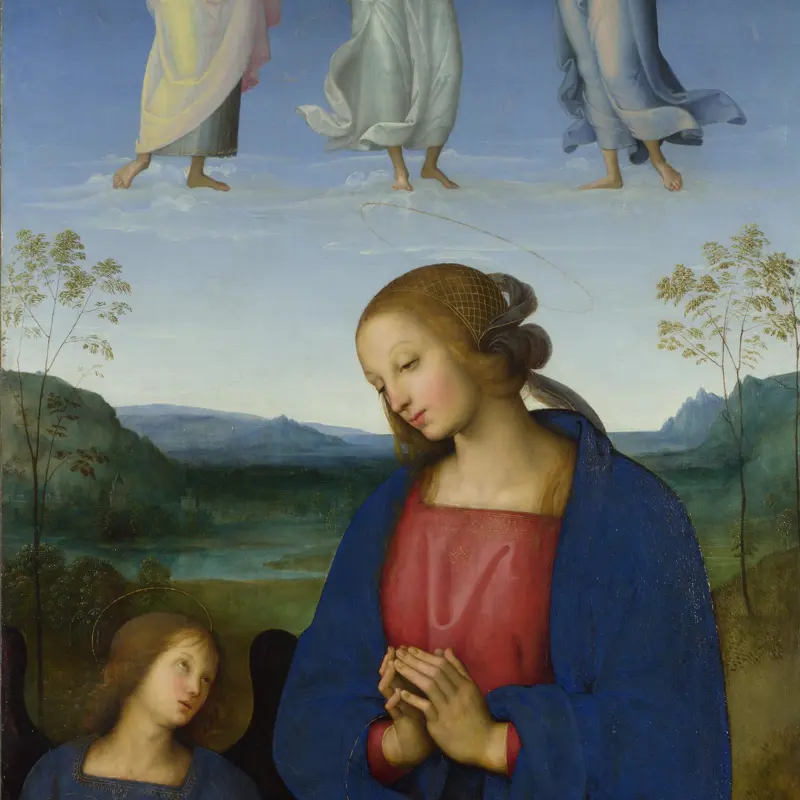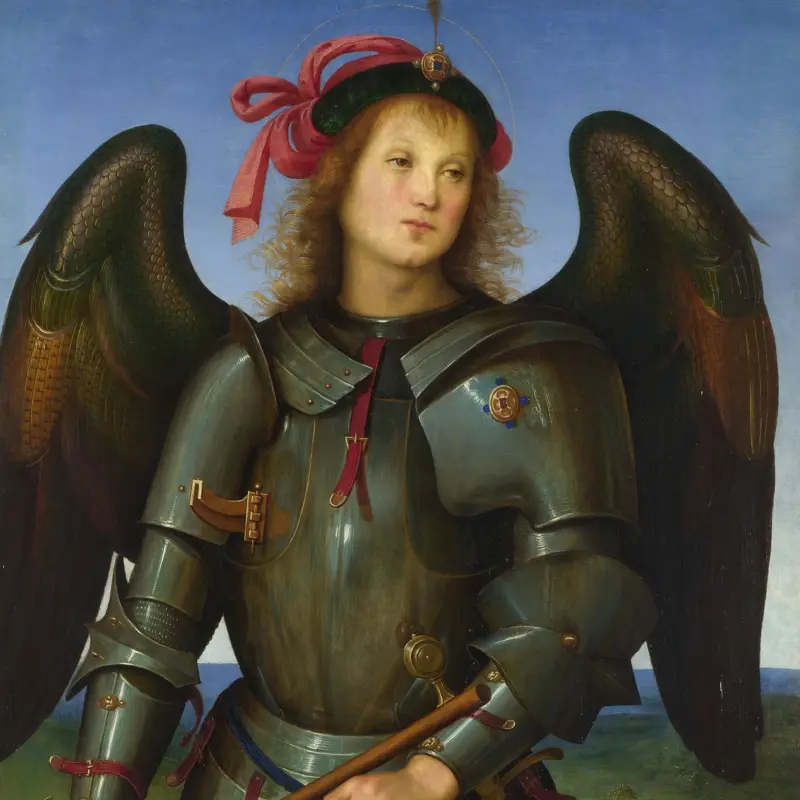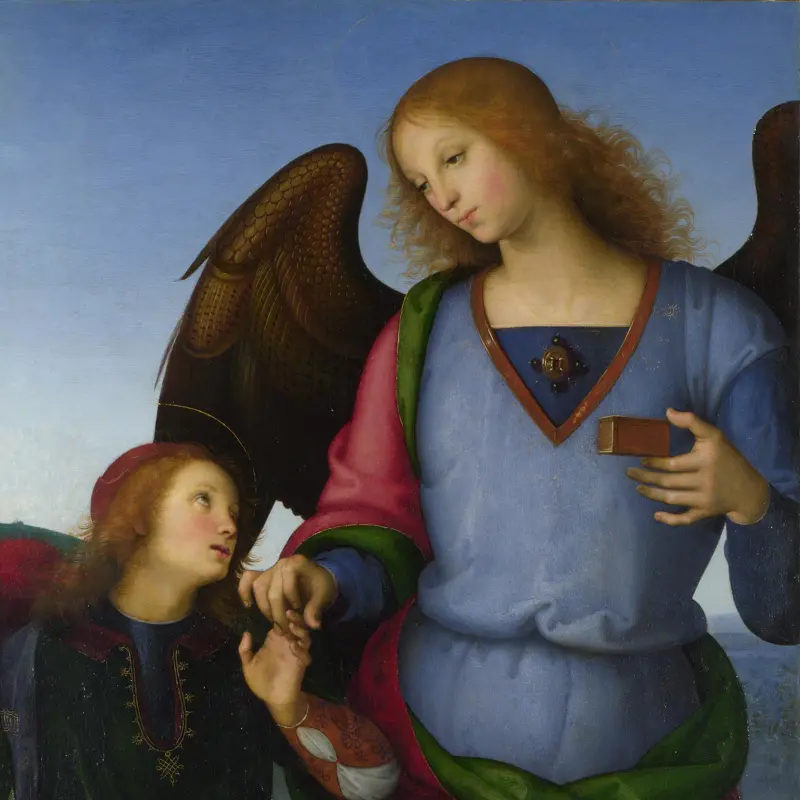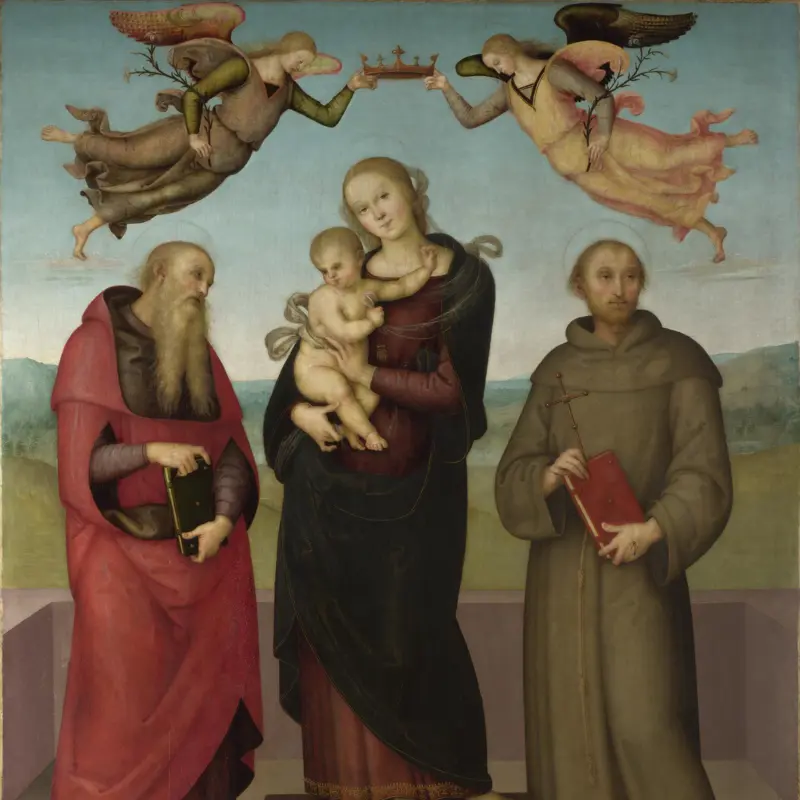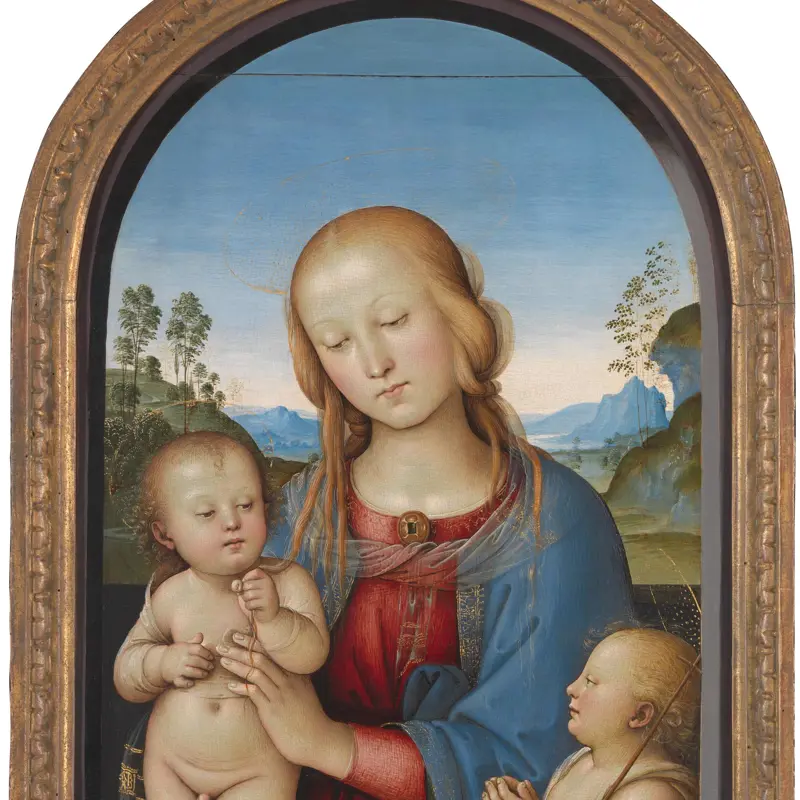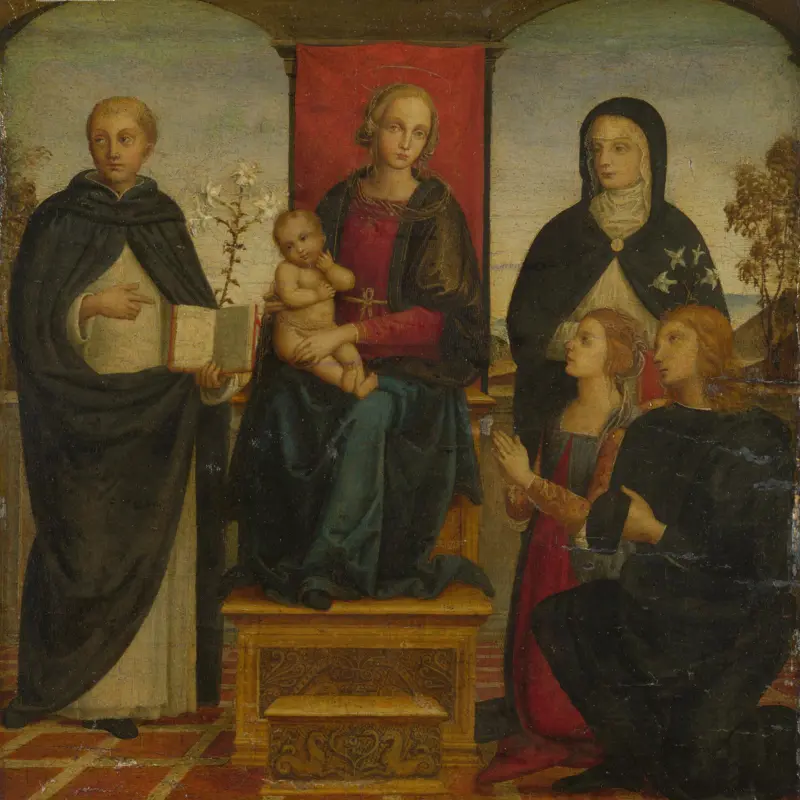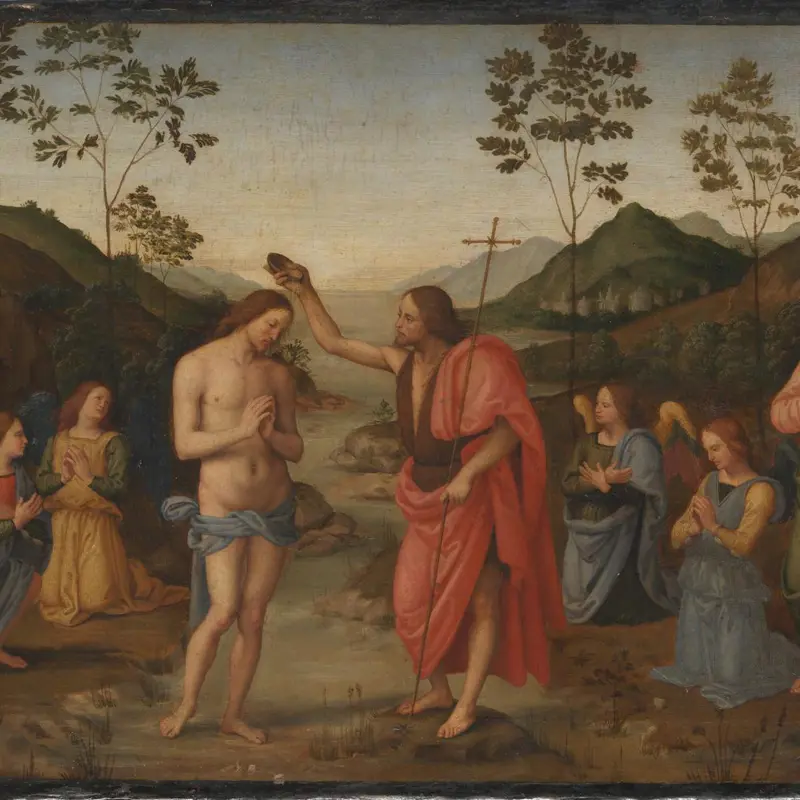Pietro Perugino, 'The Virgin and Child with an Angel', about 1496-1500
About the work
Overview
In this painting Perugino has stressed the humility of the Virgin Mary, positioning her directly in a grassy meadow as she kneels before the infant Christ, a chubby baby. He is supported by an angel who looks towards Mary, sharing in her knowledge of his divinity.
This was the central panel of the lower tier of an altarpiece made for the Duke of Milan (the two flanking panels are also in the National Gallery’s collection). It shows off the artist’s skill at painting in oil, blending colours to create subtle transitions between tones – particularly effective for painting the Virgin’s complexion, which is made up of many different shades of peach, cream and pink.
The hovering winged angels at the top of the image were not part of the original design, and it’s possible that they were added at the request of the patron.
Key facts
Details
- Full title
- The Virgin and Child with an Angel
- Artist
- Pietro Perugino
- Artist dates
- Living 1469, died 1523
- Part of the group
- Three Panels from an Altarpiece, Certosa
- Date made
- About 1496-1500
- Medium and support
- Oil on wood (probably poplar)
- Dimensions
- 114 × 63.5 cm
- Acquisition credit
- Bought, 1856
- Inventory number
- NG288.1
- Location
- Room 61
- Collection
- Main Collection
- Frame
- 21st-century Replica Frame
Provenance
Additional information
Text extracted from the ‘Provenance’ section of the catalogue entry in Martin Davies, ‘National Gallery Catalogues: The Earlier Italian Schools’, London 1986; for further information, see the full catalogue entry.
Exhibition history
-
2023Italy's best maestro. Perugino in his dayGalleria Nazionale dell'Umbria4 March 2023 - 11 June 2023
Bibliography
-
1770J.J. Volkmann, Historisch-kritische Nachrichten von Italien, 3 vols, Leipzig 1770
-
1777F. Bartoli, Notizia delle pitture, sculture ed architture, che ornano le chiese, e gli altri luoghi pubblici di tutte le più rinomate città d'Italia, Venice 1777
-
1839J.D. Passavant, Rafael von Urbino und sein Vater Giovanni Santi, 3 vols, Leipzig 1839
-
1869F.-A. Gruyer, Les Vierges de Raphaël, Paris 1869
-
1878G. Vasari, Le vite de'più eccellenti pittori, scultori ed architettori: Con nuove annotazioni e commenti di Gaetano Milanesi, ed. G. Milanesi, 8 vols, Florence 1878
-
1881E. Müntz, Raphaël: Sa vie, son oeuvre, et son temps, Paris 1881
-
1897C. Magenta, La Certosa di Pavia, Milan 1897
-
1903F. Malaguzzi Valeri, 'Il Perugino e la certosa di Pavia', Repertorium für Kunstwissenschaft, XXVI/5, 1903, pp. 372-81
-
1917O. Sirén, Italieniske handteckingar: Från 1400- och 1500-talen i Nationalmuseum, Stockholm 1917
-
1917O. Fischel, 'Die Zeichnungen der Umbrer', Jahrbuch der Königlich Preussischen Kunstsammlungen, XXXVIII, 1917, pp. 1-72
-
1923U. Gnoli, Pietro Perugino, Spoleto 1923
-
1923R. van Marle, The Development of the Italian Schools of Painting, 19 vols, The Hague 1923
-
1931F. Canuti, Il Perugino, Siena 1931
-
1951Davies, Martin, National Gallery Catalogues: The Earlier Italian Schools, London 1951
-
1956K.T. Parker, Catalogue of the Collection of Drawings in the Ashmolean Museum, vol. 2, Italian Schools, Oxford 1956
-
1959E. Camesasca, Tutta la pittura del Perugino, Milan 1959
-
1961M. Davies, The Earlier Italian Schools, 2nd edn, London 1961
-
1969E. Camesasca, Perugino, Milan 1969
-
1976L. Borgo, The Works of Mariotto Albertinelli, New York 1976
-
1980D. Bomford, J. Brough and A. Roy, 'Three Panels from Perugino's Certosa di Pavia Altarpiece', National Gallery Technical Bulletin, IV, 1980, pp. 3-31
-
1984P. Scarpellini, Perugino, Milan 1984
-
1986Davies, Martin, National Gallery Catalogues: The Earlier Italian Schools, revised edn, London 1986
-
1986F. Russell, 'Perugino and the Early Experience of Raphael', Studies in the History of Art, XVII, 1986, pp. 189-201
-
1986P.C. Marani et al., Perugino, Lippi e la bottega di San Marco alla Certosa di Pavia 1495-1511 (exh. cat. Pinacoteca di Brera, 2 December 1986 -), Florence 1986
-
1989L. Freedman, 'Raphael's Perception of the Mona Lisa', Gazette des beaux-arts, 1989, pp. 169-82
-
1990J. Plesters, 'Technical Aspects of some Paintings by Raphael in the National Gallery', in J. Shearman and M.B. Hall (eds), The Princeton Raphael Symposium: Science in the Service of Art History, Princeton 1990, pp. 15-37
-
1991J. Dunkerton et al., Giotto to Dürer: Early Renaissance Painting in the National Gallery, New Haven 1991
-
1994M.G. Ciardi Dupré, 'Riflessioni sulla "riscoperta" di Giovanni Spagna', Antichità viva, XXXIII/5, 1994, pp. 13-9
-
1995C. Gardner von Teuffel, 'The Contract for Perugino's "Assumption of the Virgin" at Vallombrosa', The Burlington Magazine, CXXXVII/1106, 1995, pp. 307-12
-
1999R. Freiherr Hiller von Gaertringen, Raffaels Lernerfahrungen in der Werkstatt Peruginos: Kartonverwendung und Motivübernahme im Wandel, Munich 1999
-
2001
C. Baker and T. Henry, The National Gallery: Complete Illustrated Catalogue, London 2001
-
2004P. Nuttall, From Flanders to Florence: The Impact of Netherlandish Painting, 1400-1500, New Haven 2004
-
2004H. Chapman, T. Henry and C. Plazzotta, Raphael: From Urbino to Rome (exh. cat. The National Gallery, 20 October 2004 - 16 January 2005), London 2004
-
2004K.E. Butler, 'Rethinking Early Raphael', in Atti del convegno internazionale su Raffaello - pluralità e unità. Bibliotheca Hertziana, 2 - 4 May 2002, Rome 2004
About this record
If you know more about this work or have spotted an error, please contact us. Please note that exhibition histories are listed from 2009 onwards. Bibliographies may not be complete; more comprehensive information is available in the National Gallery Library.
Images
About the group: Three Panels from an Altarpiece, Certosa
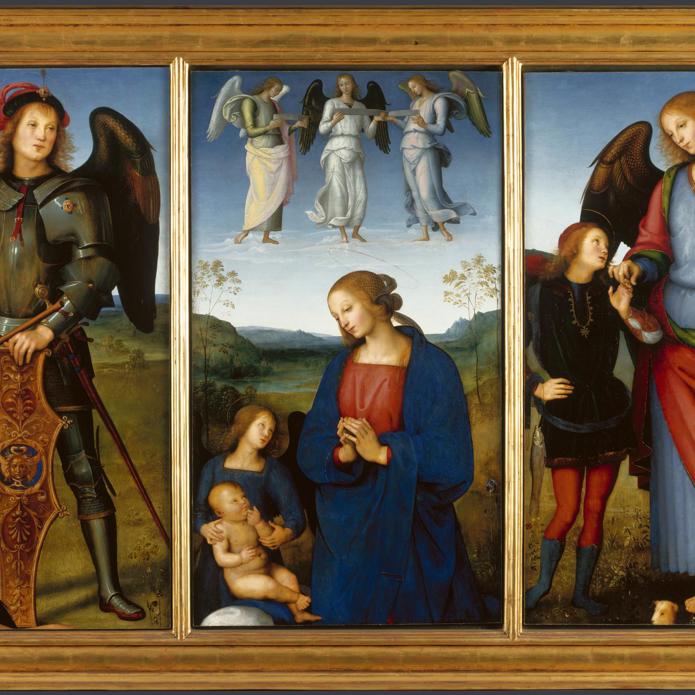
Overview
Perugino painted this altarpiece for the Duke of Milan, Ludovico Sforza. It stood in the side chapel dedicated to the Archangel Michael in the Carthusian monastery (also known as a charterhouse or certosa) in Pavia, a town outside Milan. The Duke was captured by invading French forces in 1499, and the altarpiece was completed in the early sixteenth century by two other painters: Fra Bartolommeo and Mariotto Albertinelli.
Our panels formed the lower tier of two in this large-scale construction. The upper tier showed the Annunciation: the Archangel Gabriel, on one panel, giving the Virgin Mary, on another panel, the news that she would conceive the son of God. Between these panels was an image of God in glory, which is still in the church.
The painting shows Perugino’s skill in working with oil paint. Because oil paint dries slowly, it is possible to blend different tones together to create subtle transitions, particularly evident here in the figures' flesh – their cheeks, for example, have a rosy blush.

